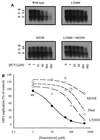Cross-resistance testing of antihepadnaviral compounds using novel recombinant baculoviruses which encode drug-resistant strains of hepatitis B virus
- PMID: 11353615
- PMCID: PMC90535
- DOI: 10.1128/AAC.45.6.1705-1713.2001
Cross-resistance testing of antihepadnaviral compounds using novel recombinant baculoviruses which encode drug-resistant strains of hepatitis B virus
Abstract
Long-term nucleoside analog therapy for hepatitis B virus (HBV)-related disease frequently results in the selection of mutant HBV strains that are resistant to therapy. Molecular studies of such drug-resistant variants are clearly warranted but have been difficult to do because of the lack of convenient and reliable in vitro culture systems for HBV. We previously developed a novel in vitro system for studying HBV replication that relies on the use of recombinant baculoviruses to deliver greater than unit length copies of the HBV genome to HepG2 cells. High levels of HBV replication can be achieved in this system, which has recently been used to assess the effects of lamivudine on HBV replication and covalently closed circular DNA accumulation. The further development of this novel system and its application to determine the cross-resistance profiles of drug-resistant HBV strains are described here. For these studies, novel recombinant HBV baculoviruses which encoded the L526M, M550I, and L526M M550V drug resistance mutations were generated and used to examine the effects of these substitutions on viral sensitivity to lamivudine, penciclovir (the active form of famciclovir), and adefovir, three compounds of clinical importance. The following observations were made: (i) the L526M mutation confers resistance to penciclovir and partial resistance to lamivudine, (ii) the YMDD mutations M550I and L526M M550V confer high levels of resistance to lamivudine and penciclovir, and (iii) adefovir is active against each of these mutants. These findings are supported by the limited amount of clinical data currently available and confirm the utility of the HBV-baculovirus system as an in vitro tool for the molecular characterization of clinically significant HBV strains.
Figures






References
-
- Allen I M, Deslauriers M, Andrews C W, Tipples G A, Walters K A, Tyrrell D L, Brown N, Condreay L D. Identification and characterization of mutations in hepatitis B virus resistant to lamivudine. Hepatology. 1998;27:1670–1677. - PubMed
-
- Aye T T, Bartholomeusz A, Shaw T, Bowden S, Breschkin A, McMillan J, Angus P, Locarnini S. Hepatitis B virus polymerase mutations during antiviral therapy in a patient following liver transplantation. J Hepatol. 1997;26:1148–1153. - PubMed
-
- Bartholomeusz A, Groenen L C, Locarnini S A. Clinical experience with famciclovir against hepatitis B virus. Intervirology. 1997;40:337–342. - PubMed
-
- Bartholomew M M, Jansen R W, Jeffers L J, Reddy K R, Johnson L C, Bunzendahl H, Condreay L D, Tzakis A G, Schiff E R, Brown N A. Hepatitis-B-virus resistance to lamivudine given for recurrent infection after orthotopic liver transplantation. Lancet. 1997;349:20–22. - PubMed
-
- Beasley R P, Hwang L Y, Lin C C, Chien C S. Hepatocellular carcinoma and hepatitis B virus. A prospective study of 22,707 men in Taiwan. Lancet. 1981;ii:1129–1133. - PubMed
Publication types
MeSH terms
Substances
Grants and funding
LinkOut - more resources
Full Text Sources
Other Literature Sources

